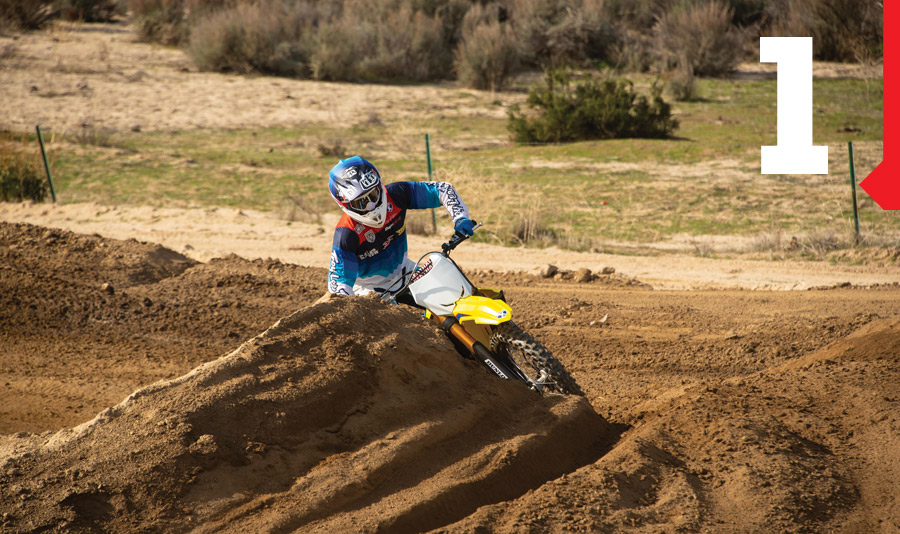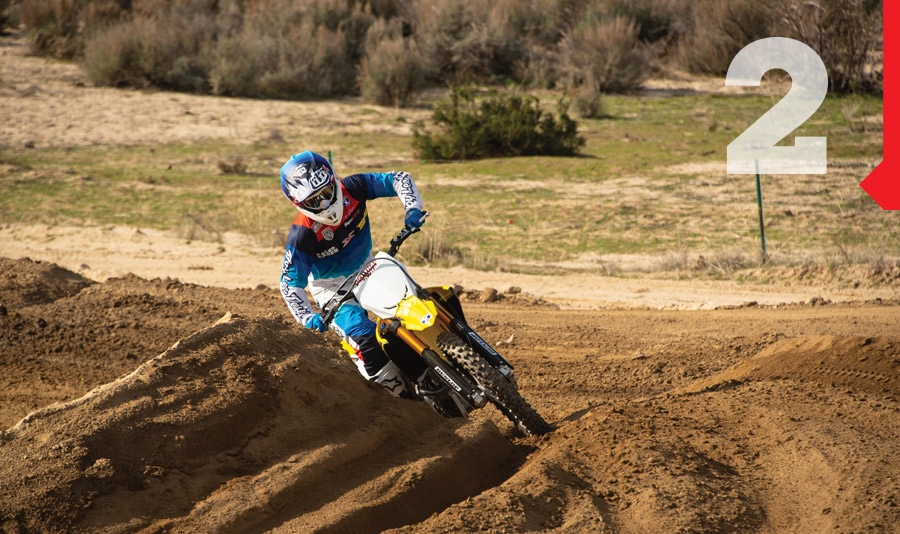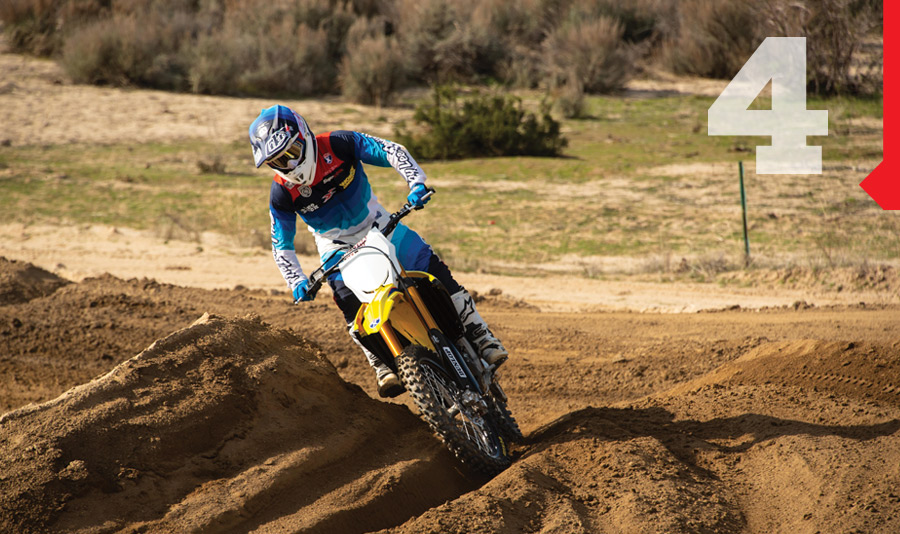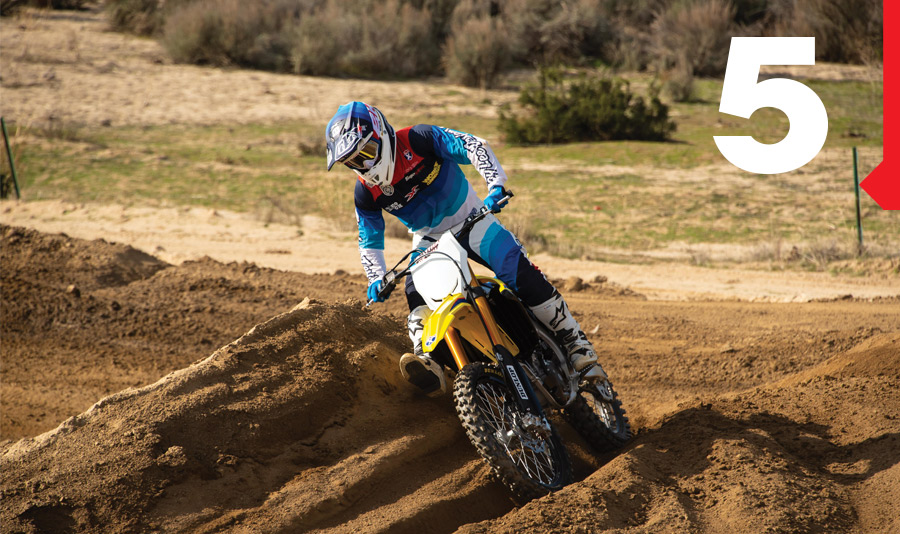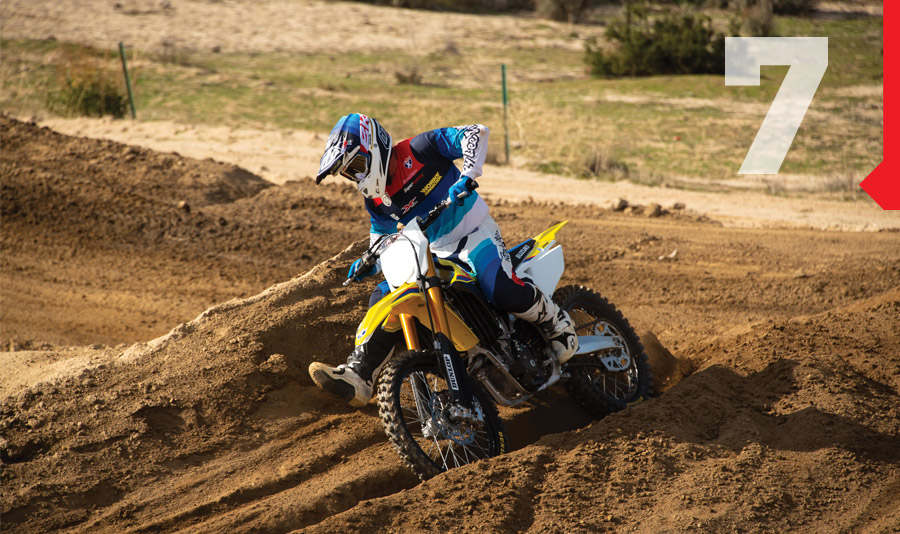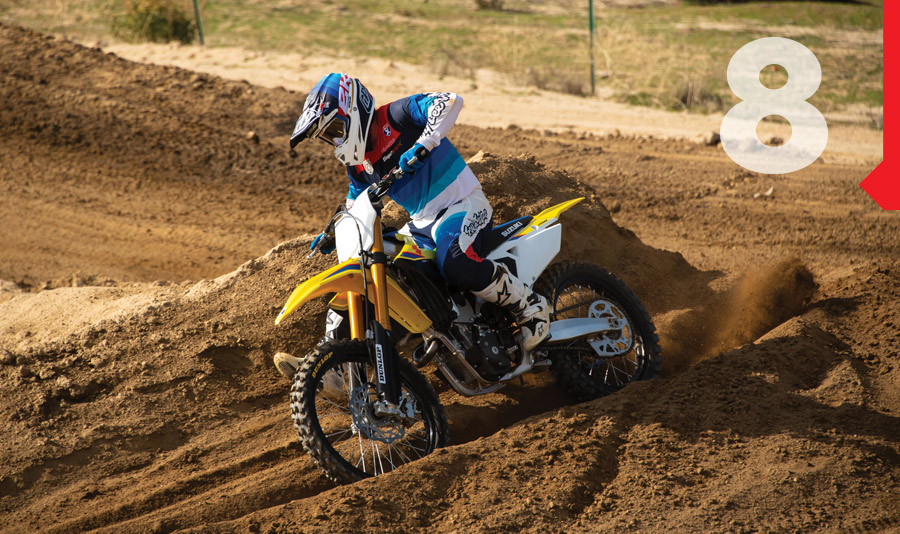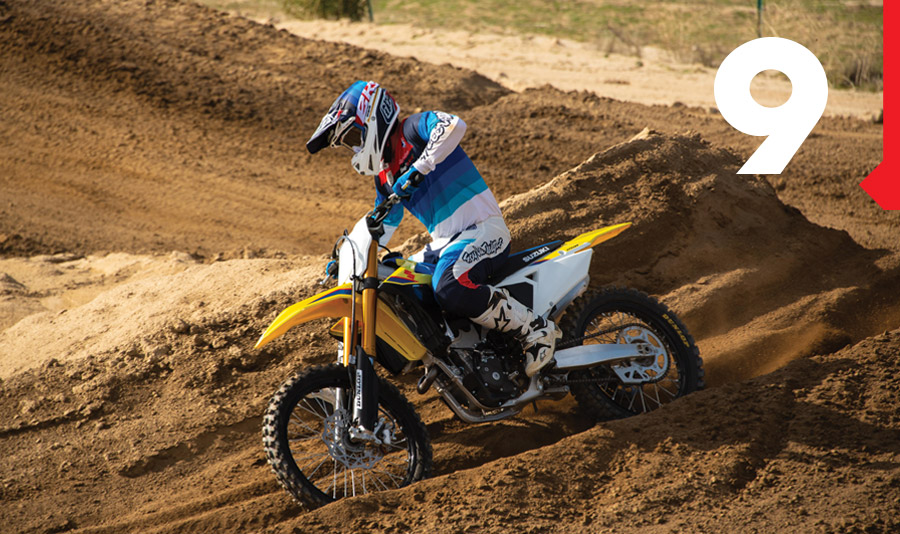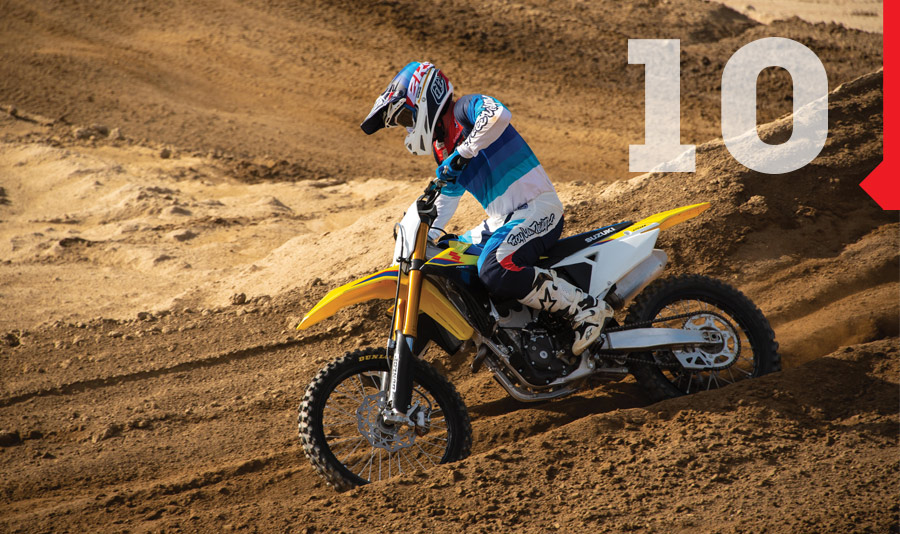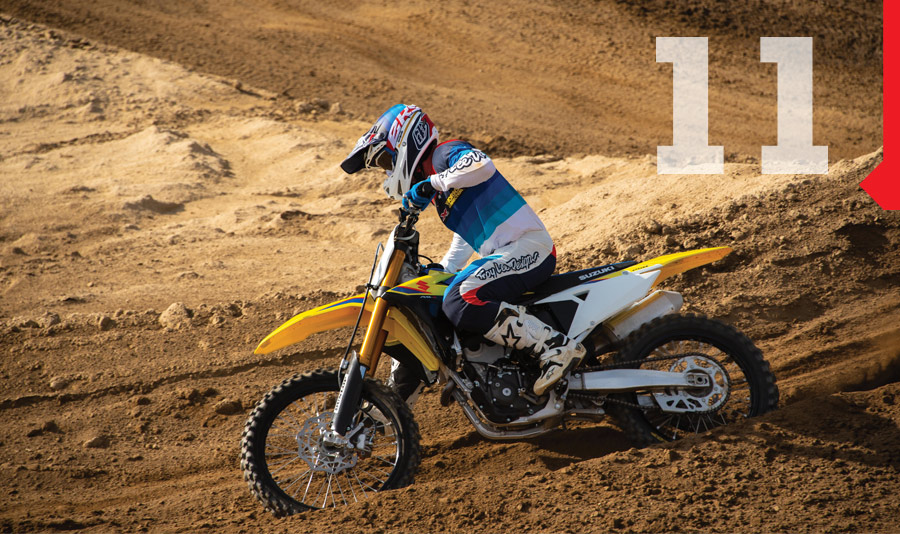


PHOTOS: SIMON CUDBY


PHOTOS: SIMON CUDBY

his month’s section at Cahuilla Creek Raceway is super technical. Sometimes you’ll see this at tracks where there’s dirt mounded up as a marker on the inside, or as an added obstacle on the track. The line in this particular turn was a rut that was deep and choppy on the exit, making it very technical and difficult to exit cleanly.
 As you enter the turn, focus on body positioning. Remember to look at where you want to go, not other ruts, bumps, or distractions. Your bike will go where you’re looking, so be deliberate about looking at the line you’ve selected. Keep your elbows up, your butt back, and your head over the triple clamps as you brake and set up for your rut. In turns like this you’re better off being patient on the entrance so you don’t make a mistake and lose major time on the exit. Smooth is fast.
As you enter the turn, focus on body positioning. Remember to look at where you want to go, not other ruts, bumps, or distractions. Your bike will go where you’re looking, so be deliberate about looking at the line you’ve selected. Keep your elbows up, your butt back, and your head over the triple clamps as you brake and set up for your rut. In turns like this you’re better off being patient on the entrance so you don’t make a mistake and lose major time on the exit. Smooth is fast.
 As you near the apex, stay on your pegs. There isn’t room to put your foot out yet without stuffing your boot into the dirt, so stay standing and begin leaning into the turn. Look as far ahead through the turn as you can see, even though the exit is likely still blocked by the dirt mound. At this point, your braking should be done and you should be focused on your transition to sitting at the apex.
As you near the apex, stay on your pegs. There isn’t room to put your foot out yet without stuffing your boot into the dirt, so stay standing and begin leaning into the turn. Look as far ahead through the turn as you can see, even though the exit is likely still blocked by the dirt mound. At this point, your braking should be done and you should be focused on your transition to sitting at the apex.
 As I hit the apex, you can see me dropping down to the seat and starting to get my foot out. This is tricky because I still have to lift my foot over the dirt pile on the inside. Keep in mind, in any turn, the transition from standing to sitting should happen as you enter the apex in one smooth motion. Braking is done, sit into the pocket of the bike, foot goes out toward the front wheel, and acceleration begins. The smoother this all happens, the better. Here, the timing of that transition is thrown off because you can’t put your foot out until you’re past the dirt mound.
As I hit the apex, you can see me dropping down to the seat and starting to get my foot out. This is tricky because I still have to lift my foot over the dirt pile on the inside. Keep in mind, in any turn, the transition from standing to sitting should happen as you enter the apex in one smooth motion. Braking is done, sit into the pocket of the bike, foot goes out toward the front wheel, and acceleration begins. The smoother this all happens, the better. Here, the timing of that transition is thrown off because you can’t put your foot out until you’re past the dirt mound.
 As you enter the turn, focus on body positioning. Remember to look at where you want to go, not other ruts, bumps, or distractions. Your bike will go where you’re looking, so be deliberate about looking at the line you’ve selected. Keep your elbows up, your butt back, and your head over the triple clamps as you brake and set up for your rut. In turns like this you’re better off being patient on the entrance so you don’t make a mistake and lose major time on the exit. Smooth is fast.
As you enter the turn, focus on body positioning. Remember to look at where you want to go, not other ruts, bumps, or distractions. Your bike will go where you’re looking, so be deliberate about looking at the line you’ve selected. Keep your elbows up, your butt back, and your head over the triple clamps as you brake and set up for your rut. In turns like this you’re better off being patient on the entrance so you don’t make a mistake and lose major time on the exit. Smooth is fast.
 As you near the apex, stay on your pegs. There isn’t room to put your foot out yet without stuffing your boot into the dirt, so stay standing and begin leaning into the turn. Look as far ahead through the turn as you can see, even though the exit is likely still blocked by the dirt mound. At this point, your braking should be done and you should be focused on your transition to sitting at the apex.
As you near the apex, stay on your pegs. There isn’t room to put your foot out yet without stuffing your boot into the dirt, so stay standing and begin leaning into the turn. Look as far ahead through the turn as you can see, even though the exit is likely still blocked by the dirt mound. At this point, your braking should be done and you should be focused on your transition to sitting at the apex.
 As I hit the apex, you can see me dropping down to the seat and starting to get my foot out. This is tricky because I still have to lift my foot over the dirt pile on the inside. Keep in mind, in any turn, the transition from standing to sitting should happen as you enter the apex in one smooth motion. Braking is done, sit into the pocket of the bike, foot goes out toward the front wheel, and acceleration begins. The smoother this all happens, the better. Here, the timing of that transition is thrown off because you can’t put your foot out until you’re past the dirt mound.
As I hit the apex, you can see me dropping down to the seat and starting to get my foot out. This is tricky because I still have to lift my foot over the dirt pile on the inside. Keep in mind, in any turn, the transition from standing to sitting should happen as you enter the apex in one smooth motion. Braking is done, sit into the pocket of the bike, foot goes out toward the front wheel, and acceleration begins. The smoother this all happens, the better. Here, the timing of that transition is thrown off because you can’t put your foot out until you’re past the dirt mound.
 At this stage I’m seated and my foot is out in the correct position. The focus here is applying the appropriate amount of throttle in relation to my lean angle. The farther you lean the bike over, the more throttle you need to apply. The tough part is that the rut is deep and rough, so powering out of the turn isn’t as easy as twisting the throttle and leaning in. Sometimes it makes more sense to lift the front wheel over bumps or try to oversteer into the rut so you aren’t getting bounced around in the rut as badly. This is all track-dependent.
At this stage I’m seated and my foot is out in the correct position. The focus here is applying the appropriate amount of throttle in relation to my lean angle. The farther you lean the bike over, the more throttle you need to apply. The tough part is that the rut is deep and rough, so powering out of the turn isn’t as easy as twisting the throttle and leaning in. Sometimes it makes more sense to lift the front wheel over bumps or try to oversteer into the rut so you aren’t getting bounced around in the rut as badly. This is all track-dependent.
 You can see here my body position moves forward to compensate for the acceleration as I apply more throttle. One common mistake is being too upright as you start to accelerate out of a corner. This will cause the front end to get too light and upset the balance and acceleration of the bike. Focus on keeping your head over the triple clamps. You can tell by the roost where I got on the throttle in the last few shots of this sequence. The smoother you can apply throttle, the better. On a 450 in particular, try to avoid dropping the clutch and instead use the throttle. Once you’re out of the rut, get your foot back on the peg and focus on shifting up as soon as possible. Over-revving is another common mistake on modern bikes. At this point, it’s also vital to look ahead to the next turn or obstacle on the track.
You can see here my body position moves forward to compensate for the acceleration as I apply more throttle. One common mistake is being too upright as you start to accelerate out of a corner. This will cause the front end to get too light and upset the balance and acceleration of the bike. Focus on keeping your head over the triple clamps. You can tell by the roost where I got on the throttle in the last few shots of this sequence. The smoother you can apply throttle, the better. On a 450 in particular, try to avoid dropping the clutch and instead use the throttle. Once you’re out of the rut, get your foot back on the peg and focus on shifting up as soon as possible. Over-revving is another common mistake on modern bikes. At this point, it’s also vital to look ahead to the next turn or obstacle on the track. ![]()
 At this stage I’m seated and my foot is out in the correct position. The focus here is applying the appropriate amount of throttle in relation to my lean angle. The farther you lean the bike over, the more throttle you need to apply. The tough part is that the rut is deep and rough, so powering out of the turn isn’t as easy as twisting the throttle and leaning in. Sometimes it makes more sense to lift the front wheel over bumps or try to oversteer into the rut so you aren’t getting bounced around in the rut as badly. This is all track-dependent.
At this stage I’m seated and my foot is out in the correct position. The focus here is applying the appropriate amount of throttle in relation to my lean angle. The farther you lean the bike over, the more throttle you need to apply. The tough part is that the rut is deep and rough, so powering out of the turn isn’t as easy as twisting the throttle and leaning in. Sometimes it makes more sense to lift the front wheel over bumps or try to oversteer into the rut so you aren’t getting bounced around in the rut as badly. This is all track-dependent.
 You can see here my body position moves forward to compensate for the acceleration as I apply more throttle. One common mistake is being too upright as you start to accelerate out of a corner. This will cause the front end to get too light and upset the balance and acceleration of the bike. Focus on keeping your head over the triple clamps. You can tell by the roost where I got on the throttle in the last few shots of this sequence. The smoother you can apply throttle, the better. On a 450 in particular, try to avoid dropping the clutch and instead use the throttle. Once you’re out of the rut, get your foot back on the peg and focus on shifting up as soon as possible. Over-revving is another common mistake on modern bikes. At this point, it’s also vital to look ahead to the next turn or obstacle on the track.
You can see here my body position moves forward to compensate for the acceleration as I apply more throttle. One common mistake is being too upright as you start to accelerate out of a corner. This will cause the front end to get too light and upset the balance and acceleration of the bike. Focus on keeping your head over the triple clamps. You can tell by the roost where I got on the throttle in the last few shots of this sequence. The smoother you can apply throttle, the better. On a 450 in particular, try to avoid dropping the clutch and instead use the throttle. Once you’re out of the rut, get your foot back on the peg and focus on shifting up as soon as possible. Over-revving is another common mistake on modern bikes. At this point, it’s also vital to look ahead to the next turn or obstacle on the track. ![]()
